| dc.contributor.author | Markou, Athanasios | |
| dc.contributor.author | Manolis, George D. | |
| dc.date.accessioned | 2019-02-05T08:48:39Z | |
| dc.date.available | 2019-02-05T08:48:39Z | |
| dc.date.created | 2018-12-04T16:10:29Z | |
| dc.date.issued | 2018 | |
| dc.identifier.citation | Journal of Theoretical and Applied Mechanics (Bulgaria) (J. theor. appl. mech.). 2018, 48 (1), 46-58. | |
| dc.identifier.issn | 0861-6663 | |
| dc.identifier.uri | http://hdl.handle.net/11250/2583857 | |
| dc.description.abstract | Numerical methods for the solution of dynamical problems in engineering go back to 1950. The most famous and widely-used time stepping algorithm was developed by Newmark in 1959. In the present study, for the first time, the Newmark algorithm is developed for the case of the trilinear hysteretic model, a model that was used to describe the shear behaviour of high damping rubber bearings. This model is calibrated against free-vibration field tests implemented on a hybrid base isolated building, namely the Solarino project in Italy, as well as against laboratory experiments. A single-degree-offreedom system is used to describe the behaviour of a low-rise building isolated with a hybrid system comprising high damping rubber bearings and low friction sliding bearings. The behaviour of the high damping rubber bearings is simulated by the trilinear hysteretic model, while the description of the behaviour of the low friction sliding bearings is modeled by a linear Coulomb friction model. In order to prove the effectiveness of the numerical method we compare the analytically solved trilinear hysteretic model calibrated from free-vibration field tests (Solarino project) against the same model solved with the Newmark method with Netwon-Raphson iteration. Almost perfect agreement is observed between the semi-analytical solution and the fully numerical solution with Newmark’s time integration algorithm. This will allow for extension of the trilinear mechanical models to bidirectional horizontal motion, to time-varying vertical loads, to multi-degree-of-freedom-systems, as well to generalized models connected in parallel, where only numerical solutions are possible. | |
| dc.language.iso | eng | |
| dc.title | Numerical solutions for nonlinear high damping rubber bearing isolators: Newmark's method with Netwon-Raphson iteration revisited | |
| dc.type | Peer reviewed | |
| dc.type | Journal article | |
| dc.description.version | publishedVersion | |
| dc.source.pagenumber | 46-58 | |
| dc.source.volume | 48 | |
| dc.source.journal | Journal of Theoretical and Applied Mechanics (Bulgaria) (J. theor. appl. mech.) | |
| dc.source.issue | 1 | |
| dc.identifier.doi | 10.2478/jtam-2018-0004 | |
| dc.identifier.cristin | 1639107 | |
| cristin.unitcode | 7452,0,0,0 | |
| cristin.unitname | Norges Geotekniske Institutt | |
| cristin.ispublished | true | |
| cristin.fulltext | original | |
| cristin.qualitycode | 1 | |
